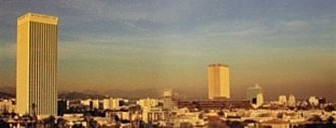
THE AIRLINE PILOTS FORUM & RESOURCE
Air Pollution |
| Source: Excerpt from The Book " Weather " |
 |

Air pollution is one atmospheric phenomenon that does not occur naturally it is the direct result of human activity. Pollution comes from many sources, including industrial processes --- particularly those that involve the burning of fossil fuels --- and automobiles. Pollution manifests itself in the atmosphere in the form of smog. Originally, this term was used to refer to a combination of smoke and fog, but now it is also used to refer to hazes that are caused by pollutants. In dry conditions, pollution will give rise to a haze that is basically a layer of smoke. However, the particles that make up the smoke dramatically increase the number of condensation nuclei in the air. This means that any water vapor present is more likely to condense and form smog. Smogs will clear only when a wind blows them away or rain disperses them. This means that the worst-affected cities are densely populated centers that receive little rainfall and regularly experience warm, clear, calm conditions, such as Mexico City and Los Angeles. The exact type of haze or smog will vary according to the emissions. The most common constituents include carbon monoxide, nitrogen oxide, hydrocarbons, and sulfur dioxide. Many of these are harmful to human health. In particular, some of these substances can cause acidic smogs, which erode buildings and pose a serious threat to people with respiratory conditions. The burning of fossil fuels may also contribute to global warming. Dense smogs caused by the burning of coal fires were a major problem in the United Kingdom from the late nineteenth century until the 1960s, when smokeless fuel was introduced. One of the worst smogs occurred in London in 1952 and probably caused the deaths of around 4,000 people from respiratory diseases. TRAPPED AIR The output of pollutants in urban areas is usually fairly uniform. However, certain meteorological conditions can greatly increase the impact of these pollutants. The most significant of these conditions is the low-level temperature inversion. This occurs when a layer of warm air, often associated with a high-pressure system, moves over a layer of cold air and prevents it from rising and dispersing. Often, the result of this phenomenon is a dark band of smog extending from the ground to a height of around 500 to 1,000 feet (150 to 300 m). As the day goes on, ground heating may erode the inversion layer from below, and once the inversion breaks, the smog may disperse fairly rapidly. However, if the inversion does not break, it is likely to intensify at night. This situation may persist for several days, raising pollution to critical levels. A city's location and surrounding topographical features can also influence pollution patterns. In Los Angeles and Sydney, for example, smogs are blown inland by sea breezes and blocked by mountains behind the city. Pollution levels also vary with seasonal weather patterns. On the west coast of the United States, during the summer months, inversions form when cool surface air from the ocean is overlaid by warmer air. These meteorological factors mean that it is impossible to reduce pollution except through the control of emissions. In many cities restrictions on industrial output and automobile use are now being enforced. |
Acknowledgement: John W. Zillman, William J. Burroughs,
Bob Crowder, Ted Robertson, Eleanor Vallier-Talbot and Richard Whitaker.

